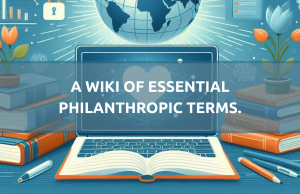The traditional anthropocentric paradigm of philanthropy is impeding support for environmental and animal welfare causes
Years ago, I stood on Montreal’s famous Sainte-Catherine street holding a petition pad in one hand and a donation pad in the other, asking people to help end animal cruelty. A man spat at my feet: ‘How could you help animals when there are children suffering?’. Interactions like this still come to mind when I reflect on the sad state of non-human philanthropy, in Canada and globally. Is there space to defend animals and the environment within the very anthropocentric constraints of Western philanthropy?
Can philanthropy be ‘non-human’?

Credit: Katherine Mac Donald/Midjourney
According to its etymological roots, philanthropy is inherently anthropocentric. Yet, countless philanthropic actors and initiatives are fighting to defend non-human causes. Animal shelters rescue abandoned pets, conservation efforts protect natural habitats and animal species, and activists defend animal rights and our natural world.
However, the non-human philanthropy niche is unique, shaped by a particular set of challenges that hinder organisations’ capacity to reach their full potential and which all stem from the anthropocentric paradigm framing western philanthropy:1 the legal framework regulating charities in Canada; the need for political advocacy to achieve its mission; and the perceived conflict between non-human and human interests.
Legal framework
The laws that govern our societies were made to regulate human activities. These often come into conflict with the interests of our non-human counterparts: animals and the environment.
Canadian charitable law, a reflection of society’s priorities, leaves little room for non-human philanthropy, be it for animals or entire ecosystems.
The Canadian charitable sector’s regulating body is the Canada Revenue Agency (CRA). In its definition of charitable purpose, environmental and animal welfare organisations often fall under the one-size-fits-all category of ‘other purposes beneficial to the community’. For example, animal shelters can register as charities under the promotion of the moral and ethical development of the community sub-category, since ‘the courts have determined that promoting the welfare of animals provides an intangible moral benefit to humanity in general’. This satisfies the anthropocentric vision of philanthropy, as defined by the Canadian government. Canadian charitable law, a reflection of society’s priorities, leaves little room for non-human philanthropy, be it for animals or entire ecosystems.
Advocacy in non-human philanthropy
One of the allowed charitable purposes in Canada is ‘upholding the administration and enforcement of the law’. What to do when the existing laws do not support your cause?
Let’s take the Fur-Bearers as an example, a Canadian charity dedicated to protecting fur-bearing animals. One of its foundational campaigns is to end cruel trapping practices. But, before it can start upholding anti-trapping laws, those laws have to be implemented. In other words, they must be advocated for. Prior to the revision of Canadian charity law in 2018, charities were forbidden from engaging in most advocacy work. Many environmental charities were even stripped of their charitable status because of their political advocacy. Since then, the regulations around advocacy have thankfully loosened. Given this context, it is possible that the sector is still reluctant to engage in, and fund, advocacy groups and their actions. This limits the possibility for non-human philanthropic entities to advocate for the legislative changes necessary to defend their causes.
In conflict or interconnected?
Another obstacle for the advancement of non-human philanthropy is the fact that non-human philanthropic activities might be perceived as being in direct conflict with human interests. I would argue, however, that this is not the case.
Animal rights organisations advocate against many legal economic activities such as fur-trapping, industrial farming and circuses, to fulfil their mission. Animal shelters will often seize neglected animals from breeders or farms, coming into conflict with individual ‘property’ rights. Nature conservation efforts lead to conflicts with natural resource exploitation activities, limiting exploitative and damaging activities in order to protect an area. Climate change activism overall aims to limit and regulate human behaviour, from carbon taxes to forced industrial recycling programmes. All of these examples can lead to the perception that non-human philanthropy comes into conflict with individual human rights as well as the capitalist, neo-liberal system we find ourselves in. Yet, this is a very limited vision of the possibilities of this philanthropic niche.
It fails to consider the fact that many of these non-human initiatives have something in common with traditionally philanthropic causes: exploitation. These causes centre around ending exploitative practices and caring for the most vulnerable. Advocating for the end of exploitative behaviour, be it of animals or our natural world is directly connected to the end of human exploitation. Carol J Adam makes the case for the shared oppression and objectification of animals and women by the patriarchal system in her book, The Sexual Politics of Meat: A feminist-vegetarian critical theory. Arguments have been made for the interconnectedness of environmentalism and human rights, with concepts such as environmental equity and justice gaining popularity, where access to a healthy environment is a right for all.

Credit: Foto-Sabine/Shutterstock
The anthropocentric bias embedded in the Western philanthropic paradigm blinds us to the fact that humans are but one component in a larger system that includes the non-human world. Our definition of philanthropy must simply evolve and take more entities into consideration. This would remove many of the structural limitations faced by the non-human philanthropic sector and allow it to flourish. It would also provide a space to reflect on the interconnectedness of all causes, building a stronger philanthropic sector overall.
An earlier version of this article was published on Alliance Magazine’s website in June 2023



